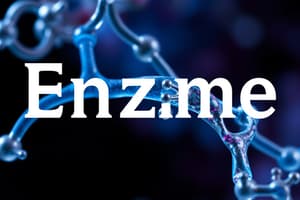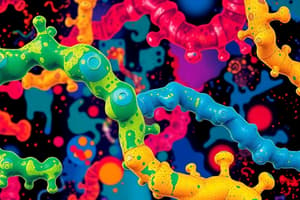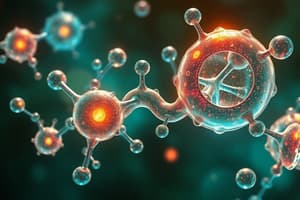Podcast
Questions and Answers
What is a chemical reaction?
What is a chemical reaction?
Involves breaking bonds, rearranging atoms, and making new bonds.
What is a catalyst?
What is a catalyst?
Anything that speeds up a chemical reaction.
What is an enzyme?
What is an enzyme?
A special kind of catalyst made of protein that speeds up a chemical reaction in living things.
What is catalase?
What is catalase?
What is the chemical equation for hydrogen peroxide being broken down by catalase?
What is the chemical equation for hydrogen peroxide being broken down by catalase?
How do enzymes work?
How do enzymes work?
What does it mean to denature an enzyme?
What does it mean to denature an enzyme?
What is activation energy?
What is activation energy?
How do enzymes speed up chemical reactions?
How do enzymes speed up chemical reactions?
What are substrates?
What are substrates?
What is an active site?
What is an active site?
What are the steps of an enzyme catalyzing a reaction?
What are the steps of an enzyme catalyzing a reaction?
What does the suffix '-ase' indicate?
What does the suffix '-ase' indicate?
Write a sentence in which you show the relationship between reactants and products in a chemical reaction.
Write a sentence in which you show the relationship between reactants and products in a chemical reaction.
Write a sentence that shows the relationship between an enzyme, a substrate, and the active site.
Write a sentence that shows the relationship between an enzyme, a substrate, and the active site.
Flashcards are hidden until you start studying
Study Notes
Chemical Reactions
- Chemical reactions involve breaking and forming chemical bonds, rearranging atoms to create new substances.
- Reactants undergo changes during chemical reactions, leading to the formation of products.
Catalysts and Enzymes
- Catalysts are substances that accelerate the rate of chemical reactions.
- Enzymes are specialized proteins that act as biological catalysts, increasing reaction rates in living organisms.
Specific Enzyme Example
- Catalase is an enzyme that catalyzes the decomposition of hydrogen peroxide into water and oxygen.
Chemical Equations
- The decomposition of hydrogen peroxide can be represented as:
- 2H₂O₂ → 2H₂O + O₂ (Reactants yield Products).
Enzyme Functionality
- Enzymes can either break down molecules or synthesize new ones.
- Each enzyme is specific to a particular reaction and can be reused multiple times without being consumed.
- Enzymes can be denatured by excessive heat or inappropriate pH levels, affecting their functionality.
- Cooling enzymes does not denature them but slows their activity.
Activation Energy
- Activation energy is the minimum energy required to initiate a chemical reaction.
- Enzymes lower the activation energy, facilitating faster reactions.
Substrates and Active Sites
- Substrates are the reactants upon which enzymes act.
- The active site is the specific region on the enzyme where substrates bind, dictated by complementary shapes.
Enzyme Catalysis Process
- Step 1: Substrates bind to the enzyme at the active site.
- Step 2: The enzyme-substrate complex undergoes a reaction, producing products.
- Step 3: Products are released, allowing the enzyme to be available for subsequent reactions.
Enzyme Nomenclature
- Enzymes typically end with the suffix “-ase” indicating their role in catalysis.
Understanding Chemical Reactions
- Reactants engage in a chemical reaction resulting in the formation of products, highlighting the transformation process inherent to chemical interactions.
Enzyme-Substrate Interaction
- The active site serves as the binding location for substrates, where the enzyme facilitates the conversion of substrates into products.
Studying That Suits You
Use AI to generate personalized quizzes and flashcards to suit your learning preferences.




